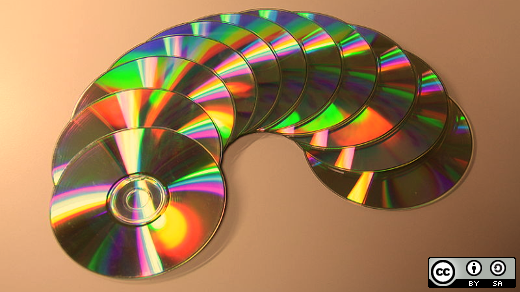I haven't had a working computer with an optical media drive in almost a year now, and the truth is, I haven't missed it. Technically I have an external USB CD/DVD device, but I haven't even pulled it out of its box.
So why have I been thinking so much about reading and writing those little round discs lately?
Just because I've stopped using DVDs and CDs (and never got into Blu-ray) doesn't mean they've gone away. Personally, I still have years worth of backups, original copies of games and music and movies, that I really ought to make backups of before they deteriorate. But there are millions of people still finding uses for physical discs every day.
Need to give away fifty copies of some chunk of data as cheaply as possible? Maybe you want to make a copy of a home movie or the modern version of a mixtape for someone who only has access to a CD or DVD player for playback. Perhaps you drive one of the tens if not hundreds of millions of cars on the road around the globe still sporting a CD player as the primary music player. Maybe you need to replace the operating system oh an older machine that just won't boot from USB.
Whatever the reason, there's still a pretty good chance we'll all still be using optical media for years to come. For those who have made the switch from proprietary to open source software in recent years, you may be on the lookout for a tool that lets you rip and burn discs with ease.
While most modern operating systems have basic facilities built in nowadays (Nautilus, a.k.a. Gnome Files, works fine if you're just looking to drag and drop some files to a disc), there are occasions where the advanced functionality of a program like Nero was useful. Here are a few open source programs for working with optical media that you ought to check out for those on a Linux system.
Brasero
Back when I was still using optical media with regularity, Brasero was my go-to program for creating CDs and DVDs. Designed for Gnome and packaged for most major Linux distributions, Brasero presents a cleanly packaged GUI interface for creating a variety of disc types. When you open it up for the first time, you are presented with choices for creating a new audio, video, or data project, along with creating a 1:1 copy of an existing disc or burning a copy of a previously created image. It also comes with a cover editor, which is not nearly as advanced as using a separate program to create your cover, but it's still a nice-to-have.
One nice thing I like about Brasero is the pluggable interface, allowing a variety of different tools to be added separately, including non-free tools for working with, for example, CSS encrypted DVD video.
Brasero's source code is kept in a git repository hosted by the Gnome Foundation, and it is available as open source under the terms of the GPL, version 2 or later.
K3b
For those more aligned to the KDE universe, K3b (short for KDE Burn Baby Burn) is a great alternative. Like Brasero, K3b supports a variety of different disc types and formats. It supports a number of different command-line tools (which we'll talk about in a bit) to be used on the back end of the application, allowing you much more control over the disc creation process. In essence, K3b is just a nice interface to these libraries.
K3b has not seen a new release in a couple of years, but the existing software is stable and fairly full-featured, so that shouldn't be a major concern for most users.
K3b is released under the terms of the GPL version 2 and its source code is available on the KDE project site.
Command-line utilities
For many who have made the switch to Linux, the command line is a compelling choice for getting things done. Why should burning optical discs be any different?
Which tool to use depends a bit on what you hope to do. Below is a brief outline of some of the tools you might consider. Each has their own set of supported features, so if you're hoping for a particular kind of disc write, do make sure your chosen tool/library supports it.
-
Cdrdao is a fairly simple tool for recording CDs in disk-at-once (DAO) mode.
-
Cdrkit is a fork of cdrtools, primarily designed to maintain the CPL license when the license of the original project changed. It is a suite of related programs for recording CD-Rs and DVDs, creating images, extracting CD audio, and related tasks.
-
Dvd+rw-tools, as its name implies, provides command-line writing tools for DVDs, but also supports the Blu-ray disc format. It does not, however, burn CDs.
-
Libburnia is a set of related tools and libraries which can burn CDs, DVDs, and Blu-ray disks.
That's it for my suggestions. What open source tools do you use for working with CDs and DVDs? There are, of course, other options beyond these obvious choices, which ones do you prefer? And of course, hopefully it goes without saying but I'll state it anyway, be sure you have the legal rights to make copies of any software, music, or movies you plan to burn.







8 Comments